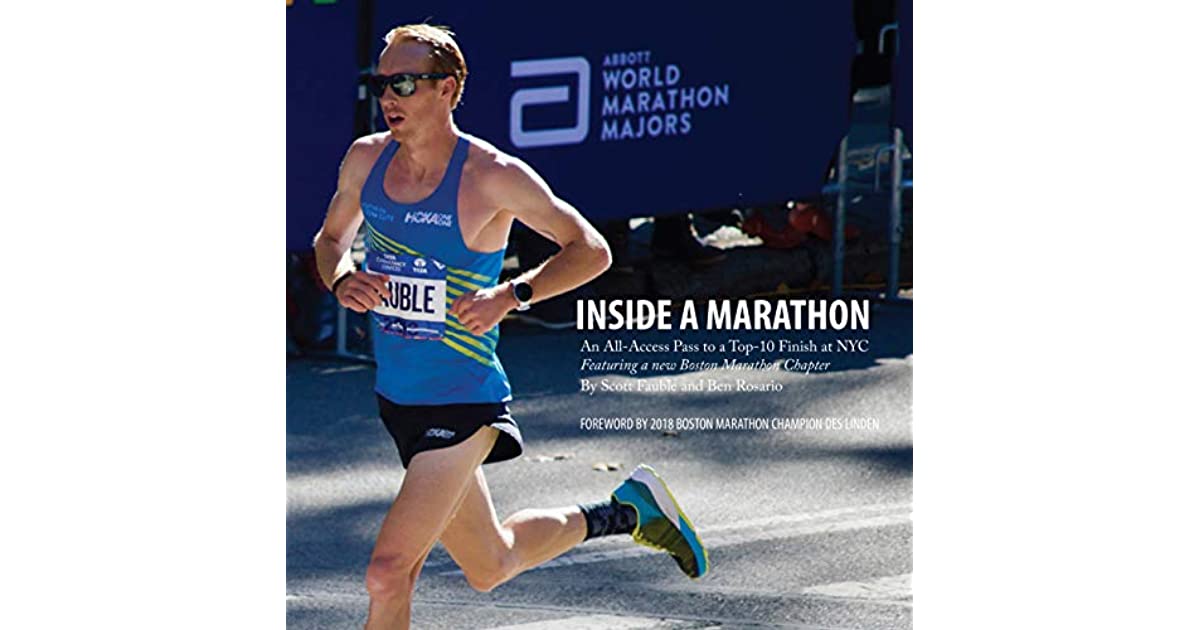The marathon is hard and painful – whether you are an elite athlete or weekend road runner.
Inside a Marathon by Scott Fauble and Ben Rosario is a rare behind the scenes look of how an elite marathoner trained for the prestigious 2017 New York City marathon. The book is co-written by Scott Fauble and Ben Rosario of the HOKA Northern Arizona Elite (“NAZ”) running group based out of Flagstaff, Arizona. Scott is a professional runner and the principal subject of the book. Ben Rosario is the NAZ head coach and equally valuable subject in the book. I purchased (what I think) is a limited edition version. My copy is autographed by Scott and Ben, which is pretty neat.

The book has a unique construction that from my experience will take the reader a few chapters with which to become familiar. Each chapter details a training week beginning with a detailed daily training. What follows are in-depth thoughts on the week first by Ben and then by Scott. Make sure to not forget the footnotes! Scott’s personality and sense of humor come to life in these anecdotes scattered across the pages. Each chapter is also filled with vivid color photos that capture each week of training. The photos alone make the book a rare peak at the training sessions at NAZ, including the picturesque training grounds of Arizona.
I give this book my strong recommendation. The chronological narrative of the daily grind of marathon training is familiar to most distance runners. The behind the scenes coaching and athlete notes offer a rare, personalized feel to the story.
Moreover, the book is filled with tangible lessons that all runners can apply to their own running goals. Here are a few takeaways that resonated with me.
It’s hard for everyone, not just weekend runners. I often watch elite runners and think how effortless they look over the final grueling miles of a marathon. I would contrast this vision with my own experiences of acute physical pain and suffering during the late stages of a race. It turns out that elites feel the same pain. My three favorite chapters in this book deal with Scott’s races in Beach to Beacon 10K, New York City Marathon, and Boston Marathon. Scott suffers and reveals this pain to the reader. The pain is as acute and real as any pain I have ever felt in a race – the principle difference is that Scott is running a much faster pace. It is reassuring about knowing that even elites suffer. Whether you struggling to break 4-hours or obtain the Olympic Qualifying Standard, you will suffer during the late stages of a marathon. Training may help delay the onset of suffering and will certainly help you run faster paces. However, you will suffer whether you are an elite runner or everyday person completing her first marathon.
Another difference is that elite runners develop strategies to cope with the pain. Through training, elites become familiar with the pain of running. When this pain arises in a race, it is a known entity that can be treated as such. Elites often deploy mental coping strategies. The book is filled with Scott’s “power phrases”, meditation practices, and mental reminders to stay present when things are difficult.
Recovery is an essential dimension of marathon training. Scott’s training logs are filled with the extra activities to help recover properly for the next workout including physical therapy, weigh training, stretching, massage, and nutrition. Amateur runners may not have the same time or resources to visit these services, but there are things we could do to mimic this program.
Stretching is something we could all incorporate into our routines. Stretching helps to lengthen leg muscles that are contracted during running. Easy ways could be a 5 minute stretch after a run. Or, 10-20 minutes while watching an evening Netflix show.
Scott also has weekly massage visits. These may be more difficult to schedule and afford for most of us; however, if interested, there are technological solutions that can help. NORMATEC is the massage boot system used by Scott. The convenience of the NORMTEC solution comes at a pricey +$1,000 cost. THERAGUN is another mechanical massage solution at a +$200 cost. Considering a typical $100 massage visit, there’s a financial payback on each of these devices in a short period of time.
Weight training is another overlooked component that is a weekly staple in Scott’s program. What we can infer from Scott’s comments is that his weight program is focused on light weight and high repetitions. Strength training seems focused on extending the period to exhaustion for leg muscles.
For us amateurs, we do not need a packed weight room to implement a strength program. Bodyweight, exercises such as squats and planks can develop stronger quadriceps and abdominal muscles. Kettlebells or barbells can add for single leg pick-ups to strengthen hamstrings.
Not every day of training is hard. In Scott’s buildup, a typical week is filled with easy paced mileage (2-3 minutes slower than marathon pace) with only 2 hard workouts per week. The focus of each week is successfully hitting workout days. Easy days are slow and easy --- the focus is gaining aerobic benefits for the heart, lungs, and legs with allowing the body to recover.
Plans need to change because things will change. This book shows the importance being adaptable in training and race planning. Even at the elite levels things happen. Sometimes Scott gets tired or hurt. Sometimes Scott is gaining fitness at the rate originally planned. This is where Ben truly shines. As the coach, Ben is constantly evaluating what he sees in Scott. He adjusts the original training plan based on what he sees to help Scott overcome rough patches and breakthrough to new level
I hope you can find time to the time to read and enjoy this book. Best wishes chasing your running goals!


